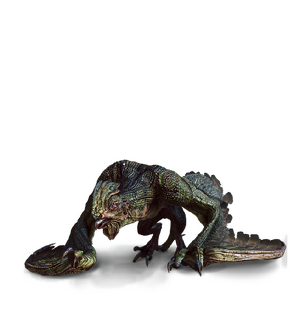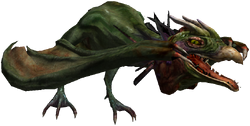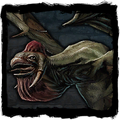Basilisks are draconids, or ornithosaurs, which sometimes terrorize communities.
Notes
- The short story, "The Bounds of Reason", features a basilisk. Geralt met Borch after the witcher had slain the draconid.
- The fourth episode of The Hexer, "Smok", was based on the short story, and thus featured a basilisk.
In The Witcher 3: Wild Hunt
| Basilisk | |
|---|---|

| |
| Details | |
Class |
Draconid |
Variations |
Silver Basilisk |
Vulnerable to |
Golden oriole potions Grapeshot bombs Draconid oils Aard |
Loot |
Basilisk venom Basilisk hide Basilisk mutagen Dragon scales Monster brain Monster blood Monster bone Monster claw Monster eye Monster heart Monster saliva Monster tongue Monster tooth |
Associated quests
Bestiary entry
- In memory of the noble knight, Roderick, slain during a valiant struggle against a basilisk. Let's hope the beast choked on his bones.
- — Gravestone inscription, Vizima cemetery.
- Contrary to popular belief, basilisks cannot turn anything to stone with their gaze. That is small comfort, however, given that their acid, venom, claws and teeth provide them many other ways to kill.
- Basilisks love dark, damp places such as cellars, caves and city sewers. They hunt by day, waiting patiently in hiding for their prey to come, then jump out in a flash to unleash a deadly attack.
- When preparing to fight such a creature one should drink Golden Oriole, which will provide resistance to its venom, and also prepare Dancing Star or shrapnel bombs, which work particularly well against basilisks.
- Basilisk leather is a highly-valued material used to make fashionable shoes and women's handbags. For this reason many men, their courage girded by goldlust, take to hunting them. Most of these hunts end in disaster, but some do manage to bag their prey, which has led to a drastic decline in this creature's numbers in recent years. Some mages and druids are of the opinion that basilisks should be included in programs meant to safeguard dying species. Everyone else thinks those mages and druids have gone completely mad.
Video
In The Witcher computer game
| Basilisk | |
|---|---|

| |
| Details | |
Class |
Ornithosaur |
Occurrence |
Basilisks choose dark and damp places like caves and abandoned canal branches as their dwellings |
Immunity |
Immune to most poisons; resistant to stun attempts |
Susceptibility |
Sensitive to silver and Ornithosaur Oil |
Tactics |
A basilisk's most dangerous weapon is its venom — one of the strongest known toxins |
Alchemy |
Venom glands |
Additional goods |
Basilisk hide |
In the game, basilisks do not appear until Chapter IV. The first encounter with them is usually on Black Tern Island, but possibly in the crypt in the fields. They are an excellent source of XP.
Journal Bestiary Entry
- "Simple people call the basilisk the king of the Zerrikanian deserts and often mistake it for a cockatrice. They claim that the beast is filled with such hatred towards all living things that even its breath is venomous and its glance turns the unwary to stone. The fact that witchers often encounter basilisks in dungeons and cellars contradicts the legend and suggests these creatures can reproduce under any conditions like many of their nasty monster brethren. In fairy tales, the only certain way to kill a basilisk is by holding a mirror in front of its eyes to divert its deadly gaze. Witchers reply that it is far better to smash the mirror on the creature's head."
Location
- Black Tern Island
- Raven's crypt
- Kaer Morhen valley (In The Price of Neutrality premium module)
Sources
- In Chapter III, Geralt can talk with a Townswoman sitting at The New Narakort. She is blonde, wearing a green dress with a yellow shirt. She will tell him she is in the mood to spin a tale but she is thirsty. Depending on her mood, she will ask for "a mug of beer" or milk. She will tell Geralt about Basilisks, Wyverns and eventually Archespores.
- Geralt must exit and then re-enter the inn (or meditate) after each tale to speak to her again. After Geralt has acquired all the entries she knows about, she will still ask for milk and beer but will not give any new tales or journal entries.
- Ornithosaurs

